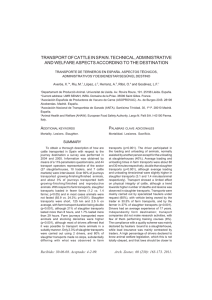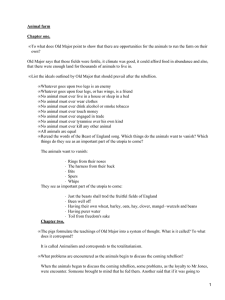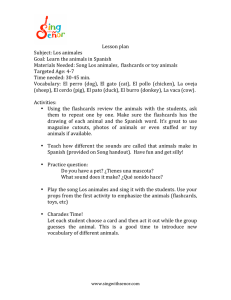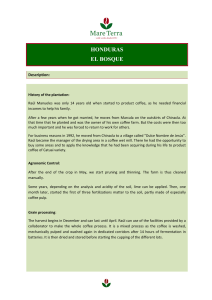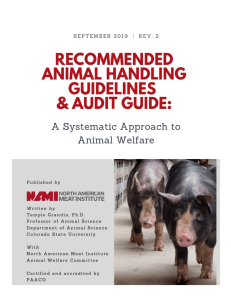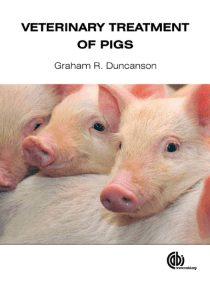HOW ARE THE PIGS TRANSPORTED IN SPAIN? DIFFERENCES
Anuncio
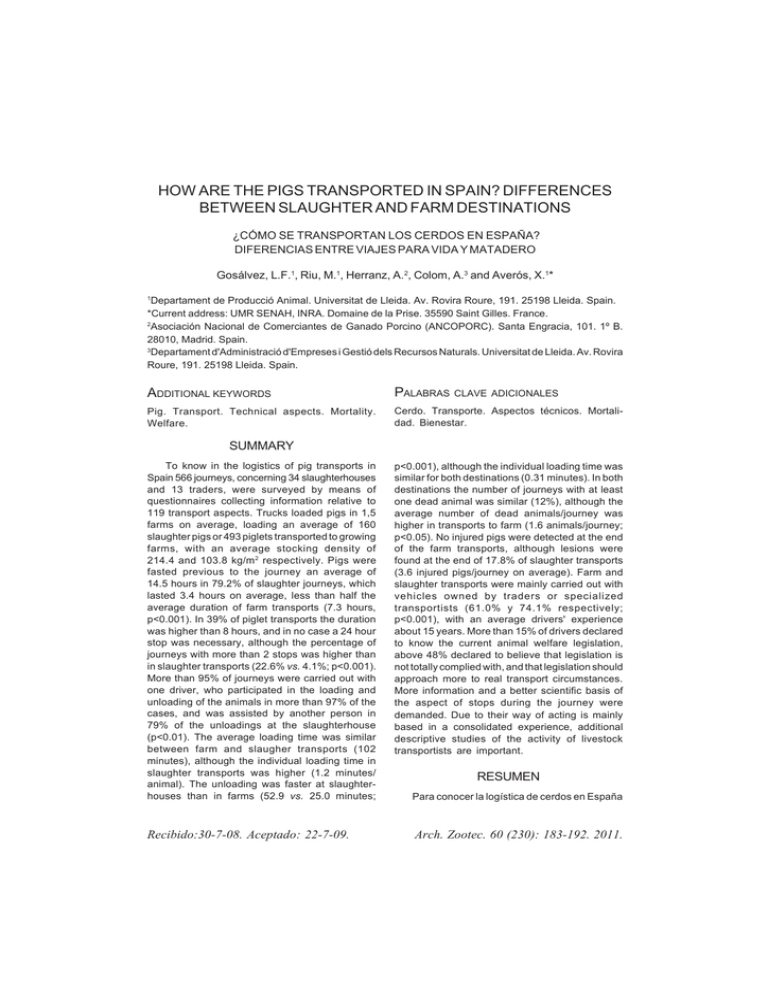
HOW ARE THE PIGS TRANSPORTED IN SPAIN? DIFFERENCES BETWEEN SLAUGHTER AND FARM DESTINATIONS ¿CÓMO SE TRANSPORTAN LOS CERDOS EN ESPAÑA? DIFERENCIAS ENTRE VIAJES PARA VIDA Y MATADERO Gosálvez, L.F.1, Riu, M.1, Herranz, A.2, Colom, A.3 and Averós, X.1* Departament de Producció Animal. Universitat de Lleida. Av. Rovira Roure, 191. 25198 Lleida. Spain. *Current address: UMR SENAH, INRA. Domaine de la Prise. 35590 Saint Gilles. France. 2 Asociación Nacional de Comerciantes de Ganado Porcino (ANCOPORC). Santa Engracia, 101. 1º B. 28010, Madrid. Spain. 3 Departament d'Administració d'Empreses i Gestió dels Recursos Naturals. Universitat de Lleida. Av. Rovira Roure, 191. 25198 Lleida. Spain. 1 ADDITIONAL KEYWORDS PALABRAS Pig. Transport. Technical aspects. Mortality. Welfare. Cerdo. Transporte. Aspectos técnicos. Mortalidad. Bienestar. CLAVE ADICIONALES SUMMARY To know in the logistics of pig transports in Spain 566 journeys, concerning 34 slaughterhouses and 13 traders, were surveyed by means of questionnaires collecting information relative to 119 transport aspects. Trucks loaded pigs in 1,5 farms on average, loading an average of 160 slaughter pigs or 493 piglets transported to growing farms, with an average stocking density of 214.4 and 103.8 kg/m 2 respectively. Pigs were fasted previous to the journey an average of 14.5 hours in 79.2% of slaughter journeys, which lasted 3.4 hours on average, less than half the average duration of farm transports (7.3 hours, p<0.001). In 39% of piglet transports the duration was higher than 8 hours, and in no case a 24 hour stop was necessary, although the percentage of journeys with more than 2 stops was higher than in slaughter transports (22.6% vs. 4.1%; p<0.001). More than 95% of journeys were carried out with one driver, who participated in the loading and unloading of the animals in more than 97% of the cases, and was assisted by another person in 79% of the unloadings at the slaughterhouse (p<0.01). The average loading time was similar between farm and slaugher transports (102 minutes), although the individual loading time in slaughter transports was higher (1.2 minutes/ animal). The unloading was faster at slaughterhouses than in farms (52.9 vs. 25.0 minutes; Recibido:30-7-08. Aceptado: 22-7-09. p<0.001), although the individual loading time was similar for both destinations (0.31 minutes). In both destinations the number of journeys with at least one dead animal was similar (12%), although the average number of dead animals/journey was higher in transports to farm (1.6 animals/journey; p<0.05). No injured pigs were detected at the end of the farm transports, although lesions were found at the end of 17.8% of slaughter transports (3.6 injured pigs/journey on average). Farm and slaughter transports were mainly carried out with vehicles owned by traders or specialized transportists (61.0% y 74.1% respectively; p<0.001), with an average drivers' experience about 15 years. More than 15% of drivers declared to know the current animal welfare legislation, above 48% declared to believe that legislation is not totally complied with, and that legislation should approach more to real transport circumstances. More information and a better scientific basis of the aspect of stops during the journey were demanded. Due to their way of acting is mainly based in a consolidated experience, additional descriptive studies of the activity of livestock transportists are important. RESUMEN Para conocer la logística de cerdos en España Arch. Zootec. 60 (230): 183-192. 2011. GOSÁLVEZ, RIU, HERRANZ, COLOM AND AVERÓS se estudiaron 566 viajes, relativos a 34 mataderos y 13 comerciantes, mediante cuestionarios que recogían información relativa a 119 aspectos del transporte. La carga se efectuó en una media de 1,5 granjas, transportando una media de 160 cerdos a sacrificio o 493 lechones destinados a granja de cebo, suponiendo una densidad media de 214,4 y 103,8 kg/m 2 respectivamente. Los cerdos fueron ayunados antes del viaje una media de 14,5 horas en el 79,2% de los viajes a matadero, cuya duración media fue de 3,4 horas, menos de la mitad de la duración media de los transportes para vida (7,3 horas, p<0,001). El 39% de los transportes de lechones duraron más de 8 horas, y en ningún caso fue necesario parar 24 horas aunque el porcentaje de viajes con más de dos paradas fue superior respecto a los transportes para sacrificio (22,6 vs. 4,1%; p<0,001). Más del 95% de los transportes se realizaron con un único conductor, que intervino en la carga y descarga en más del 97% de los casos, y fue ayudado por otra persona en el 79% de las descargas en el matadero (p<0,01). El tiempo medio de carga fue similar entre viajes a granja y matadero (102 minutos), aunque el tiempo de carga individual en los viajes para matadero fue superior (1,2 minutos/animal). La descarga fue más rápida en matadero que en granja (52,9 vs. 25 minutos; p<0,001), aunque el tiempo unitario de descarga fue similar en ambos destinos (0,31 minutos). En ambos destinos el número de viajes con al menos un animal muerto fue similar (12%), aunque la media de animales muertos/viaje fue superior en los transportes para vida (1,6 animales/viaje; p<0,05). En los viajes para vida no se observó ningún cerdo con lesiones, lesiones que fueron observadas en el 17,8% de las descargas en matadero (3,6 animales/viaje). Los viajes para vida y para sacrificio se realizaron principalmente con vehículos propiedad de los comerciantes y de los transportistas (61,0% y 74,1% respectivamente; p<0,001), con una experiencia media de los chóferes de 15 años. Más del 15% de los chóferes declaró conocer la legislación en bienestar animal, más del 48% declaró creer que la legislación no se cumple totalmente, y que la legislación debería aproximarse más a las circunstancias reales de trabajo. Se exigió más información y más fundamento en el aspecto de las paradas obligatorias. Debido a que su forma de actuar mayoritariamente se basa en una experiencia consolidada, es importante la realización de otros estudios descriptivos de la actividad de los transportistas de ganado. INTRODUCTION All farm animals are transported sometime in their life, whether from farm to farm or to the slaughterhouse. It may be generally assumed that transport is an essential part of livestock production in order to correct imbalances in geographical resources distribution and in demand. Spanish pig census is about 2.7 million sows, 7.1 million piglets, and 10.4 million fattening pigs (MAPA, 2008), with more than 40 million pigs transported either to slaughter or to farm each year. Due to the intensification of livestock practices and social changes occurred in the second half of the XXth century a social awareness about animal welfare appeared in the European countries, as well as in other parts of the Western civilization. Consequently, the governments created different laws to regulate the welfare of animals in all productive situations. In the European Union (EU) transport is currently controled by means of the Council Regulation (EC) Nº 1/2005 (2005). The economic and social importance of animal transport has also increased the number of scientific publications on this aspect of livestock production, although it should be acknowledged that there is still a lack of information on some specific points. It may be assumed that transport and its related operations are inherently stressful for animals, with some of the most important and most studied aspects being transport duration, stocking density, and environmental conditions (Warriss, 1998). Some studies have been recently published with respect to the effect of transport performed under Spanish commercial conditions on the welfare of slaughter pigs and piglets (Gosálvez et al., 2006; Averós et al., 2007, 2008a, b). Additionally, it is remarkable that, although some study exists for cattle (Villarroel et al., 2001), little or no objective information exists about the current Archivos de zootecnia vol. 60, núm. 230, p. 184. LOGISTICS OF PIGS TRANSPORTS IN SPAIN commercial transport practices in Spain. Consequently, the aim of this study was to offer a general description of the main parameters and differences between commercial pig transports to farm or to slaughter in order to provide an objective basis for future discussions. MATERIAL AND METHODS Information regarding 566 pig journeys to farm or to slaughter, carried out by Spanish operators, was obtained. The information was collected from 34 slaughterhouses and 13 pig trader companies, being chosen after different meetings with Professional Associations and Spanish Administration Representatives in order to obtain a broad and accurate description of swine transports beginning and ending in Spain. For this reason 42 journeys to farm were finally Table I. Interview, origin, and environmental characteristics of the studied pig transports according to the destination of the journey. (Característica de la encuesta, del origen y del ambiente de los viajes estudiados). Interview points (n) Interviewee (%) Trader Driver Farmer Abbatoir Journey origin (n) Spain Others Season (%) Winter Spring Summer Autum Average temperature during the journey (ºC) Winter Spring Summer Autum Farm Abbatoir 13 34 72.9 22.0 5.1 0 7.7 84.3 7.3 0.7 59 36 465 6 54.2 3.4 35.6 6.8 38.5 11.0 49.0 1.5 6.9 15.0 24.9 13.9 7.9 13.3 28.5 14.8 discarded from this study, since they had originated in other countries. Between 2004 and 2005 all transport operators were visited as many times as necessary in order to obtain a detailed description of their activity. For this reason the number of journeys per operator, being randomly chosen from among all the available journeys, was also the minimum indispensable number. When possible, the chosen journeys to be monitored were those in which the interviewer could directly observe the unloading of the animals. Each transport was monitored by means of a questionnaire collecting information about 119 different aspects related to the transported animals, the loading and unloading procedures, the journey, the means of transport, the driver, the companies involved, and some economic and administrative aspects. As shown in table I, the studied transports involved the 4 seasons, with all environmental situations being therefore represented. The number of deaths and lesions, and the typology of lesions at the end of the journey, were recorded for each transport. To determine the characteristics of transports depending on their destination (farm vs. slaughterhouse) data were statistically analyzed using SAS software (SAS Institute Inc., 2006). Discrete dependent variables were transformed into binary response variables, and the effect of the type of transport on the weighted least square estimates of these variables was studied by means of χ2 tests using the CATMOD procedure. The effect of the type of transport on continuous dependent variables was tested by means of F-tests using the GLM procedure. In case of a significant (p<0,05) effect LS means were statistically separated using t-tests. RESULTS AND DISCUSSION Table II shows the characteristics of pig transports depending on the animal Archivos de zootecnia vol. 60, núm. 230, p. 185. GOSÁLVEZ, RIU, HERRANZ, COLOM AND AVERÓS Table II. Average typology of the transported pigs according to the destination of the journey. (Características medias de los viajes estudiados, según el tipo de animal transportado a cada destino). Average live weight (kg) Journeys according to pig typology (%) Piglets < 15 kg live weight Piglets 15-21 kg live weight Fattening pigs 15-80 kg live weight Fattening pigs 81-100 kg live weight Fattening pigs 101-150 kg live weight Reproduction/cull pigs Reproduction + fattening pigs Transported animals (n/journey) Piglets <20 kg live weight Fattening pigs 15-150 kg live weight Reproduction/cull pigs Average space (m 2/animal) Piglets <20 kg live weight Fattening pigs 15-150 kg live weight Reproduction/cull pigs Average stocking density (kg/m2) Piglets <20 kg live weight Fattening pigs 15-150 kg live weight Reproduction/cull pigs Farm Abbatoir SE p 57.7 114.6 1.91 *** 13.6 57.6 5.1 3.4 3.4 23.7 0 1.1 0 1.1 49.9 32.5 17.0 0.9 -------- *** *** * *** *** ns ns 493.4 263.3 83.9 227.6 160.2 45.9 34.89 3.50 4.10 * ** *** 0.18 0.41 1.13 0.13 0.53 1.12 0.01 0.01 0.07 ns ns ns 103.8 183.0 286.3 86.6 214.4 180.1 4.82 3.27 9.32 ns ns *** SE: average standard error; ns: non significant; ***p<0.001; **p<0.01; *p<0.05. typology. As expected, a significant difference between the average weight of pigs transported to farm and those transported to slaughter was observed (57.7 kg vs. 114,6 kg; p<0.001). A significant effect of transport destination on pig typology was found, with pigs transported to farm mainly consisting in <21 kg live weight piglets (71.2%). On the other hand most of slaughter journeys transported pigs weighting between 81 kg and 150 kg (82.4%), and no differences were observed in reproduction and cull pigs transports (17% vs. 23%). Two singularities were also detected (about 1%), consisting in very young piglets transported to slaughter, what is representative of a very particular consumption model, and in trucks transporting different animal typologies during the same journey. Journeys to farm transported a higher number of pigs than those to slaughterhouse in all animal categories, although this did not imply a higher stocking density. An average of 493 piglets and 160 slaughter pigs were transported for each journey, with an average stocking density of 103.8 kg/m2 and 214.4 kg/m2 respectively. Nevertheless, a significant difference was observed in reproduction and cull pig journeys, which transported 84 and 46 animals, with an average stocking density of 286.3 kg/m2 and 180.1 kg/m2 to farm and to slaughterhouse respectively (p<0.001). Table III shows the average values of the main loading, transport, and unloading characteristics depending on the destination of pigs. No differences were observed in the average number of loading farms (about 1.5 in both destinations), and in the residual character of the journeys beginning in Archivos de zootecnia vol. 60, núm. 230, p. 186. LOGISTICS OF PIGS TRANSPORTS IN SPAIN Table III. Loading, journey, and unloading aspects according to the destination of the journey. (Características medias de la carga, descarga y desplazamiento en los viajes estudiados). Loading points (n) Type of origin farm (%) Farm Assembly centre Previous preparation Fasting (%) Fasting time (h) Participation in the loading (% citations) Driver > 1 person Loading duration Total (min) Individual (min/pig) Can you subjectively load more animals? (%) no answer Yes Transshipment (n) Change of lorry tractor (n) Drivers (%) Road typology (%) Local road A road Motorway Traffic problems (%) Stops during transport (%) 0 1 >1 Journey characteristics Distance (km) Duration (hours) Average speed (km/h) Journey duration (% of citations) >8h > 14 h > 29 h Participation in the unloading (% citations) Driver > 1 person Unloading duration Total (min) Individual (min/pig) Farm Abbatoir SE p 1.4 1.5 0.06 ns 100 0 98.1 1.9 --- ns ns 64.2 13.9 79.2 14.8 -0.33 * ns 98.3 100 97.0 99.4 --- ns ns 103.8 0.7 99.8 1.2 3.39 0.09 ns ns 3.4 62.7 0 0 2 4.7 37.4 0.02 0 5.1 --0.01 0 3.2 ns *** ns . ns 22.2 38.5 39.3 1.4 37.3 35.6 27.1 8.2 ----- ** ns * ns 54.7 22.7 22.6 70.4 25.5 4.1 * --- ns *** 436.9 7.3 62.9 187.2 3.4 53.9 10.07 0.18 0.98 *** *** ** 39.0 10.2 0 8.6 1.5 0 ---- *** *** . 100 96.6 98.3 79.0 --- ns ** 52.9 0.31 25.0 0.32 0.92 0.02 *** ns SE: average standard error; ns: non significant; ***p<0.001; **p<0.01; *p<0.05. Archivos de zootecnia vol. 60, núm. 230, p. 187. GOSÁLVEZ, RIU, HERRANZ, COLOM AND AVERÓS assembly centres, being less than 2% for both destinations. Results show that fasting pigs previous to transport is a usual handling practice, especially among those pigs transported to slaughter (79.3%; p<0.05), with no differences in fasting time appearing between destinations (14.5 hours on average). Additionally, the participation of the driver in the loading of the animals onto the truck was high for both destinations (>98% of journeys), and always being assisted by at least another person. Average loading time was 102 minutes, being approximately 1 minute/animal, showing no significant differences between destinations. Drivers participated in most of unloadings, and 21% of slaughterhouse unloadings were performed by the driver alone (p<0.01). The duration of the unloading at the slaughterhouse was shorter than in farm (25.0 vs. 52.9 minutes respectively; p<0.001), although the unloading time/pig was similar between destinations, being 0.31 minutes/pig on average. Table III also shows that, perhaps surprisingly due to some modification proposals of the current European Regulation, only 37.4% of slaughter transport drivers thought they could have loaded more animals onto the truck, while 62.7% of farm transport drivers did so (p<0.001). Slaughter transports were shorter (p< 0.001), and consequently had a shorter duration (3.4 vs. 7.3 hours; p<0.001) despite the fact that the average speed of transports to farm was higher (62.9 vs. 53.9 km/h; p<0.01). This might be attributed to the geographical location of farms and slaughterhouses in Spain, implying that a higher percentage of slaughter transports do not need to stop (p<0.05), and that very few slaughter transports effectuate two or more stops (p<0.001) with respect to farm transports. Additionally, slaughter transports travelled around more local roads (p<0.01) and less motorways (p<0.05), and encountered more traffic problems due to the fact that shorter durations imply less versatility in the route planning, although this was not statistically significant. The number of slaughter transports lasting >8 hours and >14 hours was lower than in farm transports (p<0.001), with none of them lasting >29 hours. As expected due to the journey duration, neither changes in lorry's tractor nor transhipment of animals were observed, and most of transports were performed by one driver, with only 4% of them being carried out by 2 drivers. Table IV shows the incidence of the journey on mortality and physical integrity of pigs. It is remarkable that the percentage of transports with at least one dead pig is relatively high (12.3%), being slightly higher than the average value found in another study using information collected in 5 EU contries (Averós et al., 2008b), and with no differences according to the destination of transport, but with a higher number of deaths per journey in farm transports (1.6 vs. 1.1 pigs; p<0.05). Injured animals were only detected in slaughter transports (17.8%; Table IV. Incidence of transport on the physical integrity of pigs according to the destination of the journey. (Incidencia del viaje, según destino, en la integridad física de los animales). Farm Abbatoir Mortality Journeys 1 Animals 2 Lesions Journeys 1 Animals 2 Lesion typology1 Lameness Bruise Skin wound Unespecific SE p 12.1 1.6 12.5 1.1 -0.05 ns * 0 -- 17.8 3.6 -0.48 * -- ----- 62.6 6.0 7.2 28.9 ----- ----- SE: average standard error; ns: non significant; *p<0.05. 1 %; 2 n/journey. Archivos de zootecnia vol. 60, núm. 230, p. 188. LOGISTICS OF PIGS TRANSPORTS IN SPAIN p<0.05), representing an average value of 3.6 injured pigs per slaughter transport. Injuries were mainly lameness (62.6%), what might be due to the heavier weight of slaughter pigs, and to the fact that stress is particularly evident at the end of short journeys (Bradshaw et al., 1996). Table V shows the main administrative characteristics of journeys according to their destination. Drivers mainly declared to be responsible for the transported animals, and only in 5.9% of slaughter transports the responsible for the animals was declared to be the owner of the animals or the transporting company. Although most of drivers declared to check animal condition before the loading, the percentage of slaughter drivers declaring to work following a quality control system was significantly lower than in farm drivers (25.1 vs. 53.7%; p<0.001), being this aspect closely related to the characteristics of the operating companies. Drivers declared not to have or to keep a route plan, and aspects related to the insurance were similar for both destinations, with the load being insured in 89% of journeys, and with between 75% and 80% of companies possessing a general insurance. The average professional profile of drivers and their opinion about some aspects related to animal welfare are shown in table VI. Independently from the destination, drivers had an average experience of 15 years in general transport; the experience of livestock drivers in the case of slaughter transports was significantly lower than that of farm transports (p<0.05). Despite this, less than 25% of drivers declared to have an official accreditation for animal transport, with more than 45% of drivers never having attended a training course, values being particularly higher in the case of slaughter transports (74.8%; p<0.001). Additionally, less than 5% of the interviewed slaughter transport drivers declared having attended more than one training course, values being higher in the case of farm transports. The Table V. Administrative aspects of pig transports according to the destination of the journey. (Características medias de los aspectos administrativos, según destino del viaje). Who is responsible for the animals? (%) Driver Transport company Animals' owner Check animals' body condition (%) Journey plan1 Possesses Insurance typology1 Company insurance Vehicle insurance Load insurance Quality guarantee system application (%) Farm Abbatoir p 100.0 0 0 94.1 2.5 3.4 ns ns ns 100.0 91.3 ns 0 0 -- 74.2 100.0 90.5 79.8 92.2 88.5 ns ns ns 53.7 25.1 *** ns: non significant; ***p<0.001; 1% citations. main attended courses were related to animal welfare, being double than those of general handling practices in the case of farm transports, and with farm transports drivers having attended a much more higher number of courses than slaughter transports drivers (p<0.001 and p<0.05 respectively). It is hoped that the current percentages are higher due to the fact that transportists are bound by the transport Regulation in force (Council Regulation (EC) Nº 1/2005, 2005) to follow an animal welfare training course. The subjective assessment of drivers with respect to the current European welfare legislation did not show large differences between destinations, with a higher number of farm transport drivers affirming they had knowledge of the legislation with respect to slaughter transport drivers (84.2 vs. 61.3%; p<0.01), with 46% of them believing that legislation is complied with, and acknowledging that they may sometimes not comply with current Regulation, particularly in the group of farm drivers (p<0.01). That is, they Archivos de zootecnia vol. 60, núm. 230, p. 189. GOSÁLVEZ, RIU, HERRANZ, COLOM AND AVERÓS Table VI. Average professional characteristics and opinion of drivers with respect to animal welfare according to the destination of the journey. (Características profesionales y opinión, en relación al bienestar animal, de los chóferes entrevistados). Experience (years) General transport Livestock transport Accreditation for animals transport (%) Training courses followed (% citations) No General handling Animal welfare Others Animal welfare legislation (% citations) Is complied with Is partially complied with Sometimes is not complied with I know it I do not totally comply with it It is never complied with Improvement proposals (% citations) More information for transportists Control slaughter facilities Reduce bureaucracy Better regulation of rest stops Better regulation of stocking density More cleaning and disinfection places Reduction of road controls No proposals Farm Abbatoir SE p 16.2 15.5 23.7 13.7 11.5 15.9 0.47 0.46 -- ns * ns 45.2 28.6 54.8 0 74.8 14.7 18.2 2.8 ----- *** * *** ns 51.7 13.8 3.4 84.2 24.1 6.9 41.5 21.7 18.2 61.3 5.5 13.0 ------- ns ns ns ** ** ns 7.7 7.7 0 38.5 3.8 3.8 0 38.5 17.6 16.0 2.0 11.7 7.0 2.3 3.9 40.2 --------- ns ns ns *** ns ns ns ns SE: average standard error; ns: non significant; ***p<0.001; **p<0.01; *p<0.05. admit they do not have a total knowledge of the current Regulation, maybe because of its extent, and that they, because of a contradiction between Regulation and their work, sometimes do not comply with it. The average percentage assessment of drivers' proposals to improve pig transport conditions are also shown in table VI, being remarkable the lack of an interest in proposing any improvement (40%), maybe because of mistrust on the European Administration, and the high number of drivers claiming for a scientific assessment and a revision of the stops during transit aspect (38.5%; p<0.001). It is significant that other aspects such as a reduction in bureaucracy and a reduction of road controls were proposed by less than 4% of slaughter drivers, and in any case by farm transport drivers. Pig transports' sector is very professionalized (table VII), being reflected in that vehicles are owned by traders or specialized companies. Transports to slaughter are carried out mainly by transportists having a contract with the slaughterhouse (83.9%; p<0.001), while traders mainly take on farm transports under request (46.6%; p<0.001) due to their need for flexibility in order to adapt to changes in the demand of animals, which cannot be competitively assumed with their own truck fleet. Large differences Archivos de zootecnia vol. 60, núm. 230, p. 190. LOGISTICS OF PIGS TRANSPORTS IN SPAIN Table VII. Main transport company characteristics according to the destination of the journey. (Principales características de la empresa de transporte, según destino del viaje). Vehicle owner 1 trader origin exploitation destination exploitation transportist Company activity1 specialized under request others Activities performed 2 training research Training activities2 animal welfare animal handling driving legislation others Farm Abbatoir p 61.0 5.1 0 33.9 12.7 12.5 0.7 74.1 *** ns ns *** 53.4 46.6 0 83.9 13.9 2.2 *** *** ns 52.6 43.2 13.2 6.5 *** *** 83.3 66.7 0 0 16.7 35.3 50.0 14.7 11.8 11.8 ** ns ns ns ns ns: non significant; ***p<0.001; **p<0.01. %; 2% citations. rences between destinations, with more than 50% of citations in both cases, although slaughterhouses also showed an interest in improving the knowledge of their transportists in aspects such as current legislation and driving skills. In general, an interest was detected in traders and slaughterhouses to take care of their image, particularly in the case of animal transport. This study provides with information about different transport aspects, in the context of Spain, which are in practice regulated in the European legislation concerning the welfare of animals. It should be acknowledged that, at least partially, current logistics of commercial pig transports are based on the consolidated experience of the agents involved, that in our opinion should be considered when assessing the welfare of animals from the scientific point of view. We therefore believe that additional descriptive studies of the activity of livestock transportists would supply with valuable information in the animal welfare debate. 1 ACKNOWLEDGEMENTS were detected with respect to research and training activities, with more than 40% of farm transport traders performing these activities, while slaughter transport companies performing these activities were less than 15% (p<0.001). Training activities were mainly related to animal welfare in the case of farm transportists (p<0.01). Animal handling training courses showed no diffe- Supported by funding from the Spanish Agriculture Ministry (CO-557), and European Social Fund by means of a DIUE grant (2008FIC 00187 grant). The authors are also grateful for the collaboration of Mrs M.J. Lueso, and thank ANPS, ANPROGAPOR, ANCOPORC, ASOCARNE, Fund.P.Prog. Prod.Anim., and all the companies that supported this study. BIBLIOGRAPHY Averós, X., Herranz, A., Sánchez, R., Comella, J.X. and Gosálvez, L.F. 2007. Serum stress parameters in pigs transported to slaughter under comercial conditions in different seasons. Vet. Med., 52: 333-342. Averós, X., Herranz, A., Sánchez, R. and Gosálvez, L.F. 2008a. Effect of the duration of commercial journeys between rearing farms and growing- finishing farms on the physiological stress response of weaned piglets. Livest. Sci., 122: 339-344. Averós, X., Knowles, T.G., Brown, S.N., Warriss, P.D. and Gosálvez, L.F. 2008b. Factors affecting the mortality rate of pigs being transported to slaughter. Vet. Rec., 163: 386-390. Bradshaw, R.H., Parrott, R.F., Goode, J.A., Lloyd, Archivos de zootecnia vol. 60, núm. 230, p. 191. GOSÁLVEZ, RIU, HERRANZ, COLOM AND AVERÓS D.M., Rodway, R.G. and Broom, D.M. 1996. Behavioural and hormonal responses of pigs during transport: effect of mixing and duration of journey. Anim. Sci., 62: 547-554. Council Regulation (EC) Nº 1/2005. 2005. On the protection of animals during transport and related operations and amending. Directives 64/432/ EEC and 93/119/EC and Regulation (EC) Nº 1255/97. Off. J. L 3: 0001-0044. Gosálvez, L.F., Averós, X., Valdelvira, J.J. and Herranz, A. 2006. Influence of season, distance and mixed loads on the physical and carcass integrity of pigs transported to slaughter. Meat Sci., 73: 553-558. MAPA. 2008. Encuesta ganadera. http:// www.mapa.es/es/estadistica/pags/encuesta ganadera/encuesta.htm (26/05/08). SAS Institute, Inc. 2006. Base SAS ® 9.1.3 Procedures Guide, 2 nd edition. Volumes 1, 2, 3, and 4. SAS Institute Inc. Cary, NC. USA. Villarroel, M., María, G.A., Sierra, I., Sañudo, C., García-Belenguer, S. and Gebresenbet, G. 2001. Critical points in the transport of cattle to slaughter in Spain that may compromise the animals' welfare. Vet. Rec., 149: 173-176. Warriss, P.D. 1998. The welfare of slaughter pigs during transport. Anim. Welfare, 7: 365381. Archivos de zootecnia vol. 60, núm. 230, p. 192.
